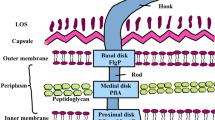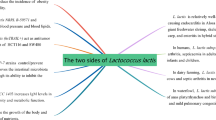Abstract
A strain of Lactobacillus paracasei subsp. paracasei BMK2005 isolated from healthy infant faeces has shown a remarkable antibacterial activity against 32 bacterial pathogenic strains of human clinical isolates. Among them, 13 strains belonging to species of Escherichia coli, Citrobacter freundii, Citrobacter diversus, Klebsiella oxytoca, Enterobacter cloacae and Pseudomonas aeruginosa were resistant to Cefotaxime (CTX) and Ceftazidime (CAZ), and 4 strains of Staphylococcus aureus were resistant to Methicillin (MRSA). This antibacterial activity was attributed to a bacteriocin designated as Paracaseicin A. It was heat-stable up to 120°C for 5 min and active within the pH range of 2–5. Its activity was lost when treated with proteases, which reveals its proteinaceous nature. This bacteriocin was successfully purified only by two steps of reversed phase chromatography. Its molecular mass, determined by mass spectrometry analysis, was 2,462.5 Da. To our knowledge, the present study is the first report on characterization and purification of a bacteriocin, produced by a L. paracasei subsp. paracasei strain exhibiting an antibacterial activity against various multidrug-resistant species of Gram-positive and Gram-negative bacteria, which reveals its potential for use in prevention or treatment of infections caused by multidrug-resistant species especially in cases of antibiotics-associated diarrhea (AAD).




Similar content being viewed by others
References
Atanassova M, Choiset Y, Dalgalarrondo M, Chobert JM, Dousset X, Ivanova I, Haertle T (2003) Isolation and partial biochemical characterization of a proteinaceous anti-bacteria and anti-yeast compound produced by Lactobacillus paracasei subsp. paracasei strain M3. Int J Food Microbiol 87:63–73
Beaugerie L, Petit JC (2004) Antibiotic-associated diarrhea. Best Pract Res Cl Ga 18:337–352
Bradford MM (1976) A rapid and sensitive method for the quantitation of microgram quantities of protein utilizing the principle of protein-dye binding. Anal Biochem 72:248–254
Brassart D, Shiffrin EJ (1997) The use of probiotics to reinforce mucosal defence mechanism. Trends Biochem Sci 8:321–326
Bujdakova H, Lausova A, Jankovicova S, Prodinge W, Kallova J, Milosovic P, Kettner M (1998) Study of β-lactam resistance in ceftazidime-resistant clinical isolates of Enterobacteriaceae. Int J Antimicrob Agents 10:135–141
CASFM (2010) Comite de l’antibiogramme de la société française de microbiologie. Recommandations 2010. http://www.sfm-microbiologie.org/pages/?page = 746&id_page = 182. Accessed 26 June 2011
Chagnaud P, Machinis K, Coutte LA, Marecat A, Mercenier A (2001) Rapid PCR-based procedure to identify lactic acid bacteria, application to six common Lactobacillus species. J Microbiol Methods 44:139–148
Cintas LM, Rodriguez JM, Fernandez MF, Sletten K, Nes IF, Hernandez PE, Holo H (1995) Isolation and characterization of pediocin L50, a new bacteriocin from Pediococcus acidilactici with a broad inhibitory spectrum. Appl Environ Microbiol 61:2643–2648
Cintas LM, Casaus P, Håvarstein LS, Hernández PE, Nes IF (1997) Biochemical and genetic characterization of enterocin P, a novel sec dependent bacteriocin from Enterococcus faecium P13 with a broad antimicrobial spectrum. Appl Environ Microbiol 63:4321–4330
Contreras BGL, De Vuyst L, Devreese B, Busanyova K, Raymaeckers J, Bosman F, Sablon E, Vandamme EJ (1997) Isolation, purification and amino acid sequence of Lactobin A, one of two bacteriocins produced by Lactobacillus amylovorus LMG P-13139. Appl Environ Microbiol 63:13–20
De Lencastre H, Duarte O, Tomasz A (2007) Antibiotic resistant Staphylococcus aureus: a paradigm of adaptive power. Curr Opin Microbiol 10:428–435
Farias LM, Totola AH, Miranda CMS, Carvalho MAR, Damasceno CAV, Tavares APC, Cisalpino EO, Vieira EC (1994) Extraction, partial purification and characterization of bacteriocin (fragilicin) produced by a strain of Bacteroides fragilis isolated form Callithrix penecillata. Res Microbiol 145:9–16
Farthing MJG, Kelly P (2007) Infectious diarrhoea. Medicine 35:251–256
Felten A, Barreau C, Bizet C (1999) Lactobacillus species identification, H2O2 production, antibiotic resistance correlation with human clinical status. J Clin Microbiol 37:729–733
Ge J, Ping W, Song G, Du C, Ling H, Sun X, Gao Y (2009) Paracin 1.7, a bacteriocin produced by Lactobacillus paracasei HD1.7 isolated from Chinese cabbage sauerkraut, a traditional Chinese fermented vegetable food. Wei Sheng Wu Xue Bao 49:609–616
Geoff S (2005) Antibiotic resistance. Medicine 33:47–51
Gillor O, Nigro LM, Riley MA (2005) Genetically engineered bacteriocins and their potential as the next generation of antimicrobials. Curr Pharm D 11:1067–1075
Guignard B, Entenza JM, Moreillon P (2005) β-lactams against methicillin-resistant Staphylococcus aureus. Curr Opin Pharmacol 5:479–489
Jack RW, Tagg JR, Ray B (1995) Bacteriocins of Gram-positive bacteria. Microbiol Rev 59:171–200
Jacobsen CN, Rosenfeldt-Nielsen V, Hayford AE, Møller PL, Michaelsen KF, Pærregaard A, Sandstrom B, Tvede M, Jakobsen M (1999) Screening of probiotic activities of forty-seven strains of Lactobacillus spp. by in vitro techniques and evaluation of the colonization ability of five selected strains in humans. Appl Environ Microbiol 65:4949–4956
Joerger MC, Klaenhammer TR (1986) Characterization and purification of helveticin J and evidence for a chromosomally determinated bacteriocin produced by Lactobacillus helveticus 481. J Bacteriol 167:439–446
Kalogeromitros D (2004) Penicillin hypersensitivity: value of clinical history and skin testing in daily practice. Allergy Asthma Proc 25:157–160
Kim CH, Ji GE, Ahn C (2000) Purification and molecular characterization of a bacteriocin from Pediococcus sp. KCA1303–10 isolated from fermented flatfish. Food Sci Biotechnol 9:270–276
Klaenhammer TR (1993) Genetics of bacteriocins produced by lactic acid bacteria. FEMS Microbiol Rev 12:39–86
Livermore DM, Woodford N (2006) The β-lactamase threat in Enterobacteriaceae, Pseudomonas and Acinetobacter. Trends Microbiol 14:413–420
Lozo J, Jovcic B, Kojic M, Dalgalarrondo M, Chobert JM, Haertle T, Topisirovic L (2007) Molecular characterization of a novel bacteriocin and an unusually large aggregation factor of Lactobacillus paracasei subsp. paracasei BGSJ2–8, a natural isolate from homemade cheese. Curr Microbiol 55:266–271
Maidak BL, Cole JR, Parker CT, Garrity GM, Larsen N, Li B, Lilburn TG, McCaughey MJ, Olsen GJ, Overbeek R, Pramanik S, Schmidt TM, Tiedje JM, Woese CR (1999) A new version of the RDP (Ribosomal Database Project). Nucleic Acids Res 27:171–173
Marcos LA, DuPont HL (2007) Advances in defining etiology and new therapeutic approaches in acute diarrhea. J Infect 55:385–393
Netz DJA, Pohl R, Beck-Sickinger AG, Selmer T, Pierik AJ, Bastos MCF, Sahl HG (2002) Biochemical characterization and genetic analysis of Aureocin A53, a new, atypical bacteriocin from Staphylococcus aureus. J Mol Biol 319:745–756
Nissen-Meyer J, Hauge HH, Fimland G, Eijsink VGH, Nes IF (1997) Ribosomally synthesized antimicrobial peptides produced by lactic acid bacteria: their function, structure, biogenesis, and their mechanism of action. Recent Res Dev Microbiol 1:141–154
Pangsomboon K, Bansal S, Martin G, Suntinanalert P, Kaewnopparat S, Srichana T (2009) Further characterization of a bacteriocin produced by Lactobacillus paracasei HL32. J Appl Microbiol 106:1928–1940
Prashar U, Bresee J, Glass R (2003) The global burden of diarrheal disease in children. Bull World Health Organ 81:236
Riley MA (1998) Molecular mechanisms of bacteriocin evolution. Annu Rev Genet 32:255–278
Rolfe RD (2000) The role of probiotic cultures in the control of gastrointestinal health. J Nutr 130:396–402
Sahl HG, Jack RW, Bierbaum G (1995) Biosynthesis and biological activities of lantibiotics with unique post-translational modifications. Eur J Biochem 230:827–853
Sanger F, Nicklen S, Coulson AR (1977) DNA sequencing with chain-terminating inhibitors. Proc Natl Acad Sci USA 74:5463–5467
Servin AL, Coconnier MH (2003) Adhesion of probiotic strains to the intestinal mucosa and interaction with pathogens. Best Pract Res Clin Gastroenterol 17:741–754
Stoddard GW, Petzel JP, Van-Belkum MJ, Kok J, McKay LL (1992) Molecular analyses of the lactococcin A gene cluster from Lactococcus lactis subsp. lactis biovar diacetylactis WM4. Appl Environ Microbiol 58:1952–1961
Sullivan A, Edlund C, Nord CE (2001) Effect of antimicrobial agents on the ecological balance of human microflora. Lancet Infect Dis 1:101–114
Thomson JM, Bonomo RA (2005) The threat of antibiotic resistance in gram-negative pathogenic bacteria: β-lactams in peril. Curr Opin Microbiol 8:518–524
Tolinački M, Kojić M, Lozo J, Terzić-Vidojević A, Topisirović L, Fira D (2010) Characterization of the bacteriocin-producing strain Lactobacillus paracasei subsp. paracasei BGUB9. Arch Biol Sci 62:889–899
Topisirovic L, Kojic M, Fira D, Golic N, Strahinic I, Lozo J (2006) Potential of lactic acid bacteria isolated from specific natural niches in food production and preservation. Int J Food Microbiol 112:230–235
Verdenelli MC, Ghelfi F, Silvi S, Orpianesi C, Cecchini C, Cresci A (2009) Probiotic properties of Lactobacillus rhamnosus and Lactobacillus paracasei isolated from human faeces. Eur J Nutr 10:345–353
Woodford N, Livermore DM (2009) Infections caused by Gram-positive bacteria: a review of the global challenge. J Infect 59:S4–S16
Acknowledgments
This study has been accomplished thanks to a research project financed by the Algerian Ministry of Higher Education and Scientific Research, and the Laboratory of ISM2, Faculty of Saint–Jerome, University of Aix-Marseille III, France. The authors would like to thank Dr. Marius Reglier, Dr. Emmanuelle Crost, Dr. André Moulin, Dr. Adjendouz El-Hassen and Dr. Harivoni Rakotoarivonina, from the laboratory of ISM2 for their collaboration and for helping to perform the experiments with HPLC and DNA analysis. As well, we are grateful to Dr. Claude Villard, Faculty of Pharmacy, La Timone, France, for the MALDI-TOF mass spectrometry analysis.
Conflict of interest
The authors declare that they have no conflict of interest.
Author information
Authors and Affiliations
Corresponding author
Rights and permissions
About this article
Cite this article
Bendjeddou, K., Fons, M., Strocker, P. et al. Characterization and purification of a bacteriocin from Lactobacillus paracasei subsp. paracasei BMK2005, an intestinal isolate active against multidrug-resistant pathogens. World J Microbiol Biotechnol 28, 1543–1552 (2012). https://doi.org/10.1007/s11274-011-0958-1
Received:
Accepted:
Published:
Issue Date:
DOI: https://doi.org/10.1007/s11274-011-0958-1




